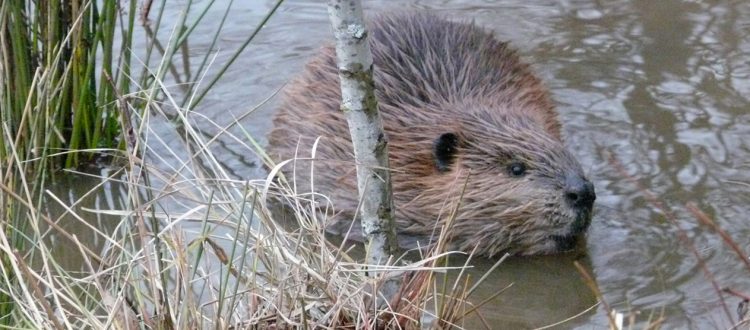Wetland Engineer
Castor canadensis, the American Beaver, a Wetland Ecosystem Engineer
By Thomas J. Slabe
Wetlands throughout most of North America are highly correlated with the American beaver (Castor canadensis), which before European settlement numbered between 60 – 400 million (Seton, 1929). Today beavers number at around 6 – 12 million (Naiman et al., 1988). Butler and Malanson (2005) reported estimated pre-European North America numbers of beaver ponds to range from a low of 15 – 100 million to a high of 37.5 – 250 million and post-European numbers of beaver ponds to range from a low of 1.5 – 3.0 million to a high of 3.75 – 7.7 million. Averages derived from estimated numbers of pre-European beaver and of beaver ponds suggest that beaver wetlands in the conterminous U.S. could easily have covered more than 85,000 square miles, a combined area equal to Lakes Superior, Huron, Michigan, and Ontario. Clearly, most beaver wetlands were permanently lost in concert with the rapid decline of the beaver population in the 18th and 19th centuries.
Importance of Beaver-Created Wetlands
Beaver prefer small streams (4th order or lower) with a stream channel gradient below 6%. However, they inhabit streams with channel gradients as high as 12% (Retzer, 1955). They also prefer valley bottoms that exceed the channel width. Indeed, the activity of beavers apparently aggrades valley bottoms as the cycle of pond creation, sedimentation, and meadow formation are repeated over the millennia (Ruedemann and Schoonmaker, 1938). Ives (1942) commented that such aggradation, which occurs at an average rate of approximately 0.04 to 0.012 inches per year in the study area in Colorado’s Grand County, produced a “false senility” of those mountain streams that resemble filled glacial lakes.
Ives (1942) presents this graphic narrative of beaver activity as is likely to occur over time in Grand County, Colorado:
“Whenever a stream is dammed by beaver, the local water table is elevated, and many of the spruce and fir trees of the montane forest are killed. Within a few years, these dead trees fall, and aspen trees, more tolerant to moist subsoil conditions, replace some of them.
During this time of active beaver occupancy, the shores and the delta beds of the pond become covered with dense brush, which is the normal pre-aspen stage in the regional plant succession. As soon as the pond is abandoned, local conditions are ideal for the rapid growth of a new aspen forest.
Because of this plant succession, the beaver, although he locally exhausts the supply of aspen trees, perpetuates his chosen forest environment, and in most instances, over a period of years, increases the extent of the valley-floor aspen forest. Thus, in a large system of valleys, such as the upper Colorado valley, the supporting power of the area for beaver tends to increase with time. Thus it should be apparent that the beaver farms, rather than mines, the forest resources of the valley he occupies.”
Beaver dams and wetlands are landscape features that attenuate surface water flow and contribute to landscape heterogeneity, species diversity, and regional plant succession regimes.
In addition to creating beaver ponds, beaver activity favors wetland creation in additional ways by reducing the kinetic energy of streams, raising the water table, creating canals, and generally increasing water storage capacity of watersheds (Collen and Gibson, 2001).
Although beaver prefer lowlands with wide valley bottoms and a low stream gradient, they in fact occupy an extremely wide array of habitats. “They have successfully colonized tundra and taiga in the far North, bottomland hardwood forests and marshes in the deep South, riparian areas in both cold and hot deserts, and elevations that vary from sea level to above 3,400 meters [11,155 feet].” (Baker and Hill, 2003) Very small wetlands and wetlands created by beavers play an important role in preserving landscape heterogeneity and biological diversity. However, for many reasons these types of wetlands are particularly vulnerable even today to loss and degradation.
Conclusion
From 1780 to 1980, wetlands loss in the conterminous U.S. occurred at a rate of 60 acres per hour (Squillase, 2006-2007). It is uncertain if this figure takes into account the loss of beaver wetlands, which eventually disappear from the landscape a couple of decades after beaver removal or abandonment (Neff, 1957). A report from the U.S. Fish and Wildlife Service (USFWS, 2005) indicates that the rate of loss of wetlands in the lower 48 states has reversed and a net gain of approximately 50 square miles was realized from 1998 to 2004. The Report indicates that only the physical extent of wetlands was measured rather than trends in the quality of wetlands. Moreover, although a net gain in palustrine wetlands was realized, a net loss would have occurred if not for an increase in total area of shallow artificial ponds, which do not provide an equivalent level of ecosystem services generally contributed by natural wetland types.
Contrary to the historical view that “wetlands presented obstacles to development, and that wetlands should be eliminated and the land reclaimed for other purposes” (Dahl and Allord, 1999), wetland ecosystems are increasingly valued by society. In 1997, Costanza et al. estimated the average annual value of ecosystem services provided by wetlands to be $14,785 per hectare ($5,986 per acre). By contrast, the reported value of ecosystem services is $8,498 ($3,440 per acre) and $969 per hectare ($392 per acre) for lakes and rivers and for forests, respectively. Although this may be a controversial and speculative measure of ecosystems services, it does indicate a positive trend toward appreciating the values attributed to wetlands. The USFWS (2005) Report likewise indicates a positive trend in the reduction in the rate of wetlands loss in the conterminous U.S. However, there remain serious unanswered questions. For example, what was the actual extent of wetlands before European settlement? What is the rate of loss of very small wetlands? Is the rate of wetland and riparian area loss and degradation outpacing protection, mitigation, and restoration efforts? Despite the historical losses of aquatic resources and the many remaining questions, there are some indications that the trends are reversing and that these resources are understood and valued more today than at any other time in history.
Thomas J. Slabe is a biologist with the U.S. EPA. This article is excerpted from “Waters of the United States” in the Spring 2007 green line Online, The Newsletter of the Colorado Riparian Association.
The 1997 Costanza study on the value of ecosystem services further subdivided the wetlands into tidal marsh/mangrove and swamps/floodplains with the value of the latter freshwater wetlands estimated to be $7,924 per acre per year.
Bibliography:
Baker, B.W., E.P. Hill. 2003. Beaver (Castor canadensis). Wild mammals of North America: biology, management, and conservation. edited by G.A. Feldhamer, B.C. Thompson, J. A. Chapman.—2nd ed. The Johns Hopkins University Press: 288-310.
Butler, D.R. and Malanson, G.P. 2005. The geomorphic influences of beaver dams and failures of beaver dams. Geomorphology 71: 48-60.
Collen, P. and R.G. Gibson, 2001. The general ecology of beavers (Castor spp.) as related to their influnece on stream ecosystems and riparian habitats, and the subsequent effects on fish – a review. Reviews in Fish Biology and Fisheries 10: 439-461.
Costanza, R., R. d’Arge, R. de Groot, S. Farber, M. Grasso, B. Hannon, K. Limburg, S. Naeem, R.V. O’Neill, J. Paruelo, R.G. Raskin, P. Sutton, M. van den Belt. 1997. The value of the world’s ecosystem services and natural capital. Nature 387: 253-260.
Dahl, T.E., G.J. Allord. 1999. History of wetlands in the conterminous United States. In National Water Summary on Wetland Resources. U.S. Geological Survey Water-Supply Paper 2425. (http://water.usgs.gov/nwsum/WSP2425/)
Gleick, P.H. 1998. The world’s water 1998-1999. Island Press, Washington, D.C.
Heimlich, R.E., K.D. Wiebe, R. Claassen, D. Gadsby, R.M. House. 1998. II. What is a Wetland? [in] Wetlands and Agriculture: Private Interests and Public Benefits. Agricultural Economics Report No. (AER756). p.p. 104. (http://www.ers.usda.gov/publications/aer765/aer765c.pdf)
Ives, R.L. 1942. The beaver-meadow complex. Journal of Geomorphology 5(3): 191-203.
Naiman, R.F., C.A. Johnston, J.C. Kelley. 1988. Alteration of North American streams by beaver. BioScience. 38: 753-762.
Neff, D.J. 1957. Ecological effects of beaver habitat abandonment in the Colorado Rockies. The Journal of Wildlife Management 21(1): 80-84.
Postal, S.L., G.C. Daily, P.R. Ehrlich. 1996. Human appropriation of renewable fresh water. Science 271: 785-788.
Retzer, J.L. 1955. Physical environmental effects on beavers in the Colorado Rockies. Proceedings of the annual conference of Western Association of State Game and Fish Commissioners, 35th. p. 279-287.
Ruedemann, R., W.J. Schoonmaker. 1938. Beaver dams as geologic agents. Science. Vol. 28(2292). p.p. 523-525.
Butler, D.R. G.P. Malanson. 2005. The geomorphic influences of beaver dams and failures of beaver dams. Geomorphology 71: 48-60.
Seton, E.T. 1929. Lives of game animals, Vol. 4, Part 2, Rodents, etc. Doubleday, Doran, Garden City, NY.
Squillace, M.S. 2006-2007. From “Navigable Waters” to “Constitutional Waters”: The future of federal wetlands regulation. University of Michigan Journal of Law Reform. Vol. 40 (4).
USACE. 1987. U.S. Army Corps of Engineers Waterways Experiment Station. Corps of Engineers Wetlands Delineation Manual. Wetlands Research Program Technical Report Y-87-1 (on-line edition). (http://el.erdc.usace.army.mil/elpubs/pdf/wlman87.pdf)
USFWS. U.S. Fish and Wildlife Service. 2005. Status and Trends of Wetlands in the Conterminous United States 1998 to 2004. p.p. 116. (http://wetlandsfws.er.usgs.gov/status_trends/national_reports/trends_2005_report.pdf)





https://waterfallmagazine.com
It’s really a nice and helpful piece of info. I’m happy that you just shared
this useful information with us. Please stay us up to date
like this. Thank you for sharing.
https://waterfallmagazine.com
Nice post. I was checking continuously this blog and I’m impressed!
Very helpful information particularly the last part 🙂 I care for such information much.
I was seeking this particular info for a very
long time. Thank you and good luck.